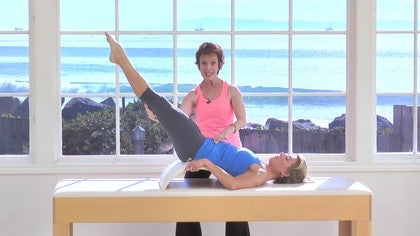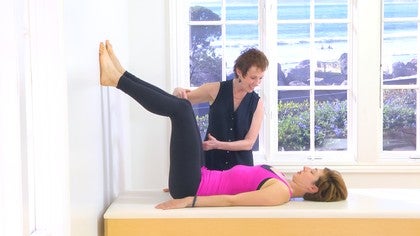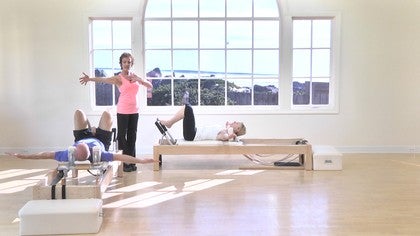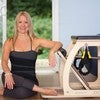Description
About This Video
Transcript
Read Full Transcript
Hi, I'm Debra Colet from Boulder, Colorado. So I want to share with you a series of exercises that I think would be really wonderful if you chose to do them every day and they are going to be familiar to you. Some of them are probably things that you do almost all the time, but I want to share with you a particular point of view, a concept that we'll be working with when you do these movements. And I'm going to ask Leslie to go through this series with me and feel free to join if you'd like to. So here you are, lying on your back, knees bent, feet on the floor. And we're looking to, as best we can align ourselves with our vertical line of the spine, our horizontals across the shoulders and collar bones, the pelvis and hips, the knees, the ankles, and even across all the ball joints of the toes. So take a moment as you lie there and feel into yourself and be curious about that. Be Curious about where are my feet? Are they rolling out? Are they rolling in?
Do my legs like to flop open? Does it take a lot of muscle tension to keep my knees in line with the center of my hips? Do I know where the center of my hips are? So if you don't, go ahead and take your hands and just, you could do this too Leslie. Just palpate that big big bone right there on the front of your pelvis and then slide your fingers in from that. There's a little bit softer area before you would hit your pubic bone and if you were going to dig your fingers gently into that area, you'd come out the other end at your sit bone and that's the center of your hip socket. And a lot of people still think about their hips out here, so that's why I just want to share that with you. Okay, so go ahead and bring your arms back down by your sides and we're just going to start with a very simple pelvic tilt. So let your tail tilt up, let your pubic bone tilt towards your belly button and that let your tail drop down and let your pubic bone stretch away from your belly button.
And just do that a couple more times. Tail up, tail down, tail up, tail down. And you don't need to lift your whole pelvis. Just feel the shift of weight in the lowest part of your spine that you can imagine up toward the top of your pelvis. So the sacrum where your waistline starts, and then let it tilt down. And now as you do that and you're, you're actually naturally doing it a little bit. As your tail tilts up, let your Chin float up too. And then as your tail tilt down, let your Chin float down. And if it feels natural, great.
If it doesn't feel entirely natural, just do it anyway. And, and your body will start to respond. This pattern will start to absorb itself into your body. It will start to make a little imprint. There you go. So as you keep going with this, you might start to feel that it's less little pieces and parts and more a continuum, right? Do you feel that? And you can actually feel not only this flow that's going on inside your body, but your connectivity to what's just outside your body going all the way through to the tip of your tail.
Do you feel the feet a little bit more when you do that? Yeah, you can feel your weight a little bit more onto your feet and you can feel the whole skull releasing back around. So you could almost imagine, right coming up into the roll up. As the tail tilts up and the Chin floats up, you could almost imagine going into rollover and then reverse it. You could be doing the teaser, right? So there's a responsiveness in your body as you do this exercise and the movement doesn't get stuck in you. The movement goes through you and it doesn't really matter if you do it bigger or smaller, but that imprint of this natural spinal wave starts to reveal itself to you. And it's a wonderful thing.
And as you keep going with this for another moment longer, I want you to consider pay attention to. As the Chin comes down and the tail floats down, stay there for another extra minute here and really soften into the front of those hips. And you can feel that right. Just keep breathing naturally. So that combination of releasing the tail down, releasing into the front of the hips puts you on your feet, right? So now do maybe two or three, just smaller. Tilt up, tilt down, not so slow this time. Tilt up, tilt down. Now on the third one, feel your feet tilt. Press with your feet and just float a couple of inches off the mat.
You feel your legs right and you feel the support of your legs into your pelvis. You're not pushing with your back, right? And then lay that and release. Let's do that one more time. It could be even smaller. Tilt the pubic bone just to the belly button. Stretch the pubic bone back down away from the belly button. Tilt the pubic bone toilets enough and then down and on this last one, very light, very light, very small inside you tilt.
Press with your feet. You don't have to tilt anymore. Just float feel. The two feet, right? The balance at the ankle bones, the balance across the horizontals of your knees, the verticality of your thigh bones deep into the hip, and then release back down. So now we're going to take what we usually would call a nice sweat. Okay, so we've done the vertical track. We've kind of opened up a flow that way. Now we want to look at the horizontals. So as you inhale, shift your weight from your left hip into your right hip and then come back on the exhale. Pretty Common, right? You've done this a billion times, shifts from your left hip into your right hip. Great job. Now as you do it, notice your legs. Notice your feet.
Are you maintaining the vertical track of the center of your knee into the center of your hip? Or there's one leg like to fall more than the other? Can You keep the legs in the same relationship to your hip sockets? And notice the shift of weight across your feet as well. Inhale. Now think about the opposite shoulder staying weighted.
Exhale, come back. Inhale, shift the weight horizontally through the pelvis, allowing the opposite shoulder to stay weighted. Exhale, come back, I doing right. Add the head. So as you wait this shoulder, see if that breath naturally invites your head to the side. And then exhale, come back couple more times. Feeling the balance of the shift of weight, not only across the horizontals of your hip line, but the horizontals of your collarbones releasing into your shoulder.
And you may find if you practice this for a while, that your, your twists, the axis of your rotation actually winds its way a little higher up the spine. And we start to get more breath, more fluidity, more openness, more connectivity, more full body awareness, less letting our legs just drag us around. Less just rotation in the lower back. But the potential for bigger breath, more vitality, more balanced, work through the spine and come back. You want to try putting it together? Okay.
So shift over to your left shoulder and now tip the tail on the Chin Up. Come back through center. Tip the Chin and the tail down and come back through center. So you're gonna make a circle or like a rectangle. Okay? So revisit really quickly for yourself. Tail Up, Chin Up, Chin down, tail down. So that's that one, right?
And then you can add that to the horizontal. All right? Don't think too hard. Okay, so rural to the side. There you go. Tip The tail on the Chin Up. Roll to the center weight. Tip the Chin and the tail down and you get to the other side.
Tip Your Chin and your tail up.
Notice what happens when you get confused about where you are. What happens when we start to shift our weight through our body and suddenly we find ourselves somewhere out on the edge. We don't really know how we got there and we have to grab titan brace to come back. So you can practice this. Any of these movements as an would it drive you crazy to go the other way? Don't think chin down, tail down as an exploration of shifting weight through your body parts to do movements to move around in your life, to learn to pay attention. How did I get there? What happened down there at my knee? What happened over there in my foot?
I wonder. I keep feeling that pain in my SSI joint. It's always being yanked around. Come back to center. Take a nice deep breath. And now we're going to add another piece. So we've worked up and down the spinal way through our vertical line.
We've worked the horizontals, the rotation, and then we put it together. Okay, now we're going to free this hip up all by itself. So you will maybe bring your hand onto your belly just to get out of the way. So keeping your left leg right where it is, feel into the balance across all 10 toes, the two sides of your ankle, the two parts of your pelvis. All right? And now allow your right leg to start to roll to the side. As soon as you feel resistance, tension grabbing, start to use your left foot to help you shift your weight so that you can allow your right leg to honestly rest.
Allow the table to come up underneath it and let that go. Okay, now notice the alignment through your thigh into your hip, right? So if you're feeling your knee pressure, what happened to your foot? Did you lose the equalness across your ankle? Right? Of course. So now think of that outside half of your pelvis. Lift the leg, feel the weight shift itself to the center of your foot, and come back to a balanced state. When do it again? Yeah. Okay.
So feel the weight shift across your right foot, allowing your right hip to open. When you feel the resistance, don't push it. Don't force it. Give a little bit of support from your left foot so that you can shift your weight so that the weight has shifted sufficiently so your leg can get to the table. It can have a moment of support. Okay, good. I can let go. And then come back. If you've just released that, you don't want to grip it to come back, right?
So how do you change the weight? The outer part of your right pelvis is going to [inaudible] circle around, pick your leg up for you. Notice the weight come back and center yourself. So when I first started doing this exercise, I was very uneven, both sides and so tight on one side that I used to roll a towel and have the towel waiting for me on the floor so that the floor wasn't so far away. So that might be something that that you want to play with too. Okay.
So should we try the other side? Alright. So allow your native float to the side. As soon as you feel resistance, instead of grabbing and pulling with that leg, gently press through your right foot to guide the shift of weight horizontally through your pelvis until your left leg can actually rest on the table. If you want to check in with the rest of your body than it's interesting, right? Do I still feel the balance across my right foot or did I twist it?
Did I lose my outer heel? Is My knee collapsing because I'm no longer balanced between the horizontals of my ankle? Where's the alignment here? Okay. And then to come back, feel that outer left half of your pelvis. Pick your leg up, center you and come back. Okay, great job. So now go ahead and bring your arm back down and I just want to play for a moment with your leg itself. Okay. So you've done knee folds a million times, right? So we talked about, we talked about this flow, the shift of weight.
We've talked about it in a lot of different directions and we've talked about the moments in between, right? Where you're gonna do something and then do something else. So when you had to pick your, pick your leg up to do your knee fold, essentially what has to happen is that you have to relinquish the amount of weight that's on your foot and shift that into the hip. Do you feel that? And then when you go to put it down again, you have to have enough strength and range around that hip so that the weight of your leg, which is like a load pulling on, you can come happily back down to the floor without having to grip or pull on your back, right? So take the breath and as you exhale, you just focus on letting the weight sink deeper and deeper of the weight of your thighbone into your hip.
And I do some of the work of holding your leg right and then take another breath. Feel the weight on your right foot, helping to make the load on your pelvis lighter. You remember your tilts, right? And then you can float this foot down. One more time. Take a breath, exhale, feel the depths of that theme or bone in the socket. And if I were to take your leg closer to you, you'd want to keep that sense of softening and deepening, almost like a little ladle that would scoop the underside of your pelvis around and release your lower back. You see? And then the weight on your right leg is still there.
Just enough to keep a lightness underneath. Right? And you little by little, your body learns how to hold this leg up, not only from the front of your thigh and that surface hip flexor. One more time. Take a breath. Exhale. Feel the depth. Yeah. All right.
And then when you go to put it down, [inaudible] feel the support from the other side. Feel how, okay, now I get to put my foot down. Do I know where my foot is in space? Can I consciously aim that foot to the mat so that when the majority of my weight has arrived, I've got a foot to stand on. Not just a quad. Okay? So if I wasn't here to help you, there's, you know, you could, you could hold your pants, you know, you could grab a hunk of your tights, you could obviously put a theraband or something, but you can also do this series and other things like this with your legs up against a wall. Here we are at the wall and now you see the wall is holding your legs up, right? So you want to take a moment and actually acknowledge that.
So it's not just like, oh, I'm laying on my back and I stuck my feet up against the wall. And because I'm kind of Picky, let's get your feet at the same height. So one more time, revisit this relationship of your parts. It's a slightly different angle. It's easier maybe because the legs are higher, right?
So there's less pull on your lower back, right? It's easier for your thighs to feel their way down into your sockets. Okay, so here we are again. We've got our vertical flow. Okay, we have our awareness of horizontals and now you can essentially just lift your leg. However, it's really interesting to feel how much really do I need to do to pick this foot off the floor? You know, it's not appalling in, yeah, it's just a releasing. It's a releasing.
It's choosing to relinquish the amount of weight that's on the foot and give it into the hip, give it into the hip, and allow your, the work that you've already done today that opened up your spine and opened up your breath to be the, the foundation, the support for that action. I mean, in a way we could think of this as walking, you know? Yeah. How do you shift your weight now? How do you shift the weight? Go ahead and then what if you wanted to do something else with this leg? What if you wanted to do another exercise for now? I'll hold the weight, right?
Give me the weight of your leg and start to straighten it. This is where things get dicey, right? How much can you keep giving me the weight of your leg? Don't push me. Don't push me. Keep thinking deep, soft, depth, full thoughts of that femur. The more you can see there we are, the more you can sinkhole that femur down, down, down, and release your weight up, the less gripping you're going to have. Right? Right. Okay, so now give me the weight of your leg until you get your foot to the wall.
Your job is to use me and soon you'll use the wall to keep reminding yourself to go soft, to go deep. You can play with this by feeling how the wall is now holding your leg up as if I weren't here. It's so much harder when your leg is straight, right, than when your knee is bent. But we do a lot of exercises where we're trying to hold our legs up straight. How do we feel that connectivity in your mind? Can you remember the tilt release, tilt, release, tilt, press through the feet to feel that lightness of your pelvis so when you can feel that connection from your foot into the support of your pelvis, it's as if some body, something is actually coming up underneath of you and making you lighter and freer so that your leg moves inside your body, your body comes up to meet that movement.
You're not just lying there trying to pull this heavy thing in and out, but you're, the whole breath wave is going on and all the balance of the parts. And then when you release the weight of the foot into the hip, it'll go, there you go. This float, that leg can just be a teeny bit, right? And then you put it back down. It's great, right? One more, Lisa. There you go. And it's not grabbing is it? So you could play with this. You could play with sliding your leg up and down. All the things that we do with our feet on the mat, but having this support of the wall. That's right. So every slide you make, you just keep going deeper and deeper and deeper. And then on the way back up, sometimes it helps if you wear socks.
So you can actually be a little bit more slippery. Take your time, take your time. How many times in a Pilati is mat do you slide your heel down the mat, straighten your leg. How many times do you get stuck by the time you're done with this quad? All turned on and no access to the back of your leg. Right? But now release the weight onto the wall, release it onto the wall, use the wall, start to slide your leg. Keep thinking those deep, soft, I'm going to say dark thoughts, but I don't mean dark thoughts. Just depths, full thoughts, right? You're like is light, isn't it?
Yeah, I mean you can just float that thing right off. And that's the leg that you want to be doing single leg circle with, right? Totally. And this leg that you want to do single leg circle with is attached to the shift of weight that you did in your rolling tail, Tipping, rolling tail, tipping right. And the whole rest of your body gets to be a part of the act. Okay, great. So now bend your knee, put your foot back on the wall.
And a couple more things just because they're really fun to do on a wall. This one, these two are our direct from each entry. So this first one is called the inchworm. Again, we've, we've done exercises like this as you crawl your way up the wall, right? You're going to dome the foot, the heel stays there, push off your heel and make your way up the wall. So you Paul, you lift your arches like you were doing foot corrector or the towel and you don't, the foot push off the heel release and up the wall dome. Push off the heel, release the wall. Yeah. So when you don't, your heel gets dragged up toward the ball of your foot. You feel that? Yeah.
Now leave your heel where it is.
I'm doing the inchworm and then as it settles down and practices and starts to imprint the pattern over and over, then you can pull in more of the things that you've already practiced. It practiced. So as you, as you pull through that dome, are you still connected to the outer inner, Inner, outer hip, the outer inner inner, outer knee? I could say a million things to you about where to put the weight on your foot, how to do this, what to do, but simply put, if you come back to the pattern and the concept that you're trying to work with, which is this constant relationship of your verticals and your horizontals, at a certain point, you'll look up and you'll see that foot and you'll see that it's twisted and you'll think, Aha, I lost one of my horizontals. And then you'll just work with that and it will start to make a change all the way down. So now we're going to reverse it, right? So you don't backwards. You pull your toes back and keep your hill where it is.
You don't and pull bend as much as you can. See if you can get all those medic tarsals to abandon every single toe on the wall and then push off the toes and walk your heel back down. Good job. I know that. That's wicked, right? Dome Paul. First Time you've had me do this, I thought I was gonna Scream. It was like nails on a chalkboard. I was so bad at it that it just, it drove me crazy. Right? So you're doing a great job. So one more time, just pull. Don't try to get all five.
Push off the toes. Come down to the heel. Okay. So if it really drives you crazy, you can do one leg at a time so that you don't have to manage the two legs working together. All right, so now bring your legs and feet together. We're going to do one last exercise to kind of wrap up this whole thing about hips freeing themselves up. Okay? It's called snaking feet. Okay. So you're going to flex back dorsiflex back through your ankles, and now as you rotate out, okay, make sure you still feel your deep, soft depth, full hips so that you really feel that's where you're initiating the movement from, right? Not the need of the foot.
And then reach with that whole foot and plant the balance across your horizontals. Okay? Now lift your heels. Pivot on the entire structure of the Metta tarsals turn internal Lee and place your heel flex back externally. Reach for the wall with your toes. Lift the heel internal, feel it. Turn first in the hip, place your foot. Keep going out. Rotate and place with the heel is where it starts to get a little tricky.
If your hip is tight, right? Don't just pull on your ankle all the way. Maybe one more. Okay. Flex, rotate and reach. So you can go as far as you can go. Maintaining the balance of the parts. I know you don't get to just push it and then what's interesting, you're great. A lot of times when I see people do it, one full tire than the other leg, you know, and so that's interesting too. So now I'll start to come back. Okay, so dorsiflex internally rotate not any farther.
There you go. Lift the heel. External pivot, feel that left big toe and put it down. Lift, pivot on the center of your heel. Turn in and reach you. Stick. You're starting to get how you want to do more in one place than the other. Lift external, rotate, turn out, turn out. Now.
Ooh, the other way. There you go. And place the heel and then lax. Turn in, started at the hip. Feel the depth. Feel the ground. That's it. A couple more, and you'll be home. Turn out, place the heel. Last one, flex. Turn in and place the feet.
And just for fun, see if you can now release both legs and just float those feet off the wall. Take your time. Take a nice breath. No weight in the feet. Now it's in. There you go. Pretty good, right? That's amazing. Okay, and so what's amazing about it? I'm a hip flexor gripper forever. Yeah.
I haven't felt them once this entire time. That's wonderful. That's wonderful. Great. Thank you.
Mindful Movement: Transitional Moments
Comments
It opened up my mind to teach a simple movement like, Knee fold, as the integration of the body in motion.
It ultimately builds up a natural way of body awareness, rhythms, and balance.
I truly appreciate your wonderful work, Debora!
You need to be a subscriber to post a comment.
Please Log In or Create an Account to start your free trial.



















